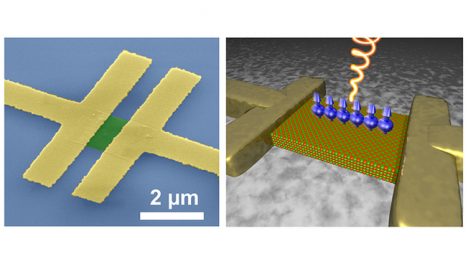Nano-crystals created in wet chemicals, meaning in a solution, can already be found in the latest TV screens or in image-making diagnostic procedures in medicine. A research group headed by CUI member PD Dr. Christian Klinke from the Institute of Physical Chemistry at Universität Hamburg has now demonstrated a special feature in such nanostructure: in lead sulfide nano platelets, circular-polarized lights (used for example in 3D movies) can direct electrons and create oriented currents. This makes cheaper and better-performing transistors and computer chips conceivable. The research findings have now been published in the journal Nature Communications.

Left: two-dimensional lead sulfied nano platelet (green) in contact with two gold electrodes; circular-polarized light hitting a nano-platelet, controlling electron spin, creating contact, and thus currents (right). Credit: UHH/Klinke
Read on in German. A translation is coming soon.
Citation:
Moayed M.M.R., Bielewicz Th., Zöllner M. S., Herrmann C. & Klinke Ch.
“Towards colloidal spintronics through Rashba spin-orbit interaction in lead sulphide nanosheets”
Nature Communications 8, 15721 (2017)
DOI:10.1038/ncomms15721

